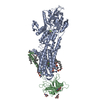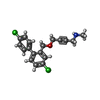+ Open data
Open data
- Basic information
Basic information
| Entry | Database: PDB / ID: 8ijv | ||||||
|---|---|---|---|---|---|---|---|
| Title | Cryo-EM structure of the gastric proton pump with bound DQ-02 | ||||||
 Components Components |
| ||||||
 Keywords Keywords | MEMBRANE PROTEIN / P-type ATPase / P2-type ATPase | ||||||
| Function / homology |  Function and homology information Function and homology informationregulation of proton transport / pH reduction / cation-transporting ATPase complex / potassium:proton exchanging ATPase complex / P-type potassium:proton transporter activity / Ion transport by P-type ATPases / P-type sodium:potassium-exchanging transporter activity / sodium:potassium-exchanging ATPase complex / sodium ion export across plasma membrane / plasma membrane protein complex ...regulation of proton transport / pH reduction / cation-transporting ATPase complex / potassium:proton exchanging ATPase complex / P-type potassium:proton transporter activity / Ion transport by P-type ATPases / P-type sodium:potassium-exchanging transporter activity / sodium:potassium-exchanging ATPase complex / sodium ion export across plasma membrane / plasma membrane protein complex / intracellular sodium ion homeostasis / potassium ion import across plasma membrane / potassium ion binding / ATPase activator activity / intracellular potassium ion homeostasis / potassium ion transmembrane transport / proton transmembrane transport / cell adhesion / apical plasma membrane / response to xenobiotic stimulus / magnesium ion binding / ATP hydrolysis activity / ATP binding / plasma membrane Similarity search - Function | ||||||
| Biological species |  | ||||||
| Method | ELECTRON MICROSCOPY / single particle reconstruction / cryo EM / Resolution: 2.1 Å | ||||||
 Authors Authors | Abe, K. / Yokoshima, S. / Yoshimori, A. | ||||||
| Funding support |  Japan, 1items Japan, 1items
| ||||||
 Citation Citation |  Journal: Commun Biol / Year: 2023 Journal: Commun Biol / Year: 2023Title: Deep learning driven de novo drug design based on gastric proton pump structures. Authors: Kazuhiro Abe / Mami Ozako / Miki Inukai / Yoe Matsuyuki / Shinnosuke Kitayama / Chisato Kanai / Chiaki Nagai / Chai C Gopalasingam / Christoph Gerle / Hideki Shigematsu / Nariyoshi Umekubo / ...Authors: Kazuhiro Abe / Mami Ozako / Miki Inukai / Yoe Matsuyuki / Shinnosuke Kitayama / Chisato Kanai / Chiaki Nagai / Chai C Gopalasingam / Christoph Gerle / Hideki Shigematsu / Nariyoshi Umekubo / Satoshi Yokoshima / Atsushi Yoshimori /  Abstract: Existing drugs often suffer in their effectiveness due to detrimental side effects, low binding affinity or pharmacokinetic problems. This may be overcome by the development of distinct compounds. ...Existing drugs often suffer in their effectiveness due to detrimental side effects, low binding affinity or pharmacokinetic problems. This may be overcome by the development of distinct compounds. Here, we exploit the rich structural basis of drug-bound gastric proton pump to develop compounds with strong inhibitory potency, employing a combinatorial approach utilizing deep generative models for de novo drug design with organic synthesis and cryo-EM structural analysis. Candidate compounds that satisfy pharmacophores defined in the drug-bound proton pump structures, were designed in silico utilizing our deep generative models, a workflow termed Deep Quartet. Several candidates were synthesized and screened according to their inhibition potencies in vitro, and their binding poses were in turn identified by cryo-EM. Structures reaching up to 2.10 Å resolution allowed us to evaluate and re-design compound structures, heralding the most potent compound in this study, DQ-18 (N-methyl-4-((2-(benzyloxy)-5-chlorobenzyl)oxy)benzylamine), which shows a K value of 47.6 nM. Further high-resolution cryo-EM analysis at 2.08 Å resolution unambiguously determined the DQ-18 binding pose. Our integrated approach offers a framework for structure-based de novo drug development based on the desired pharmacophores within the protein structure. | ||||||
| History |
|
- Structure visualization
Structure visualization
| Structure viewer | Molecule:  Molmil Molmil Jmol/JSmol Jmol/JSmol |
|---|
- Downloads & links
Downloads & links
- Download
Download
| PDBx/mmCIF format |  8ijv.cif.gz 8ijv.cif.gz | 302.3 KB | Display |  PDBx/mmCIF format PDBx/mmCIF format |
|---|---|---|---|---|
| PDB format |  pdb8ijv.ent.gz pdb8ijv.ent.gz | 216.9 KB | Display |  PDB format PDB format |
| PDBx/mmJSON format |  8ijv.json.gz 8ijv.json.gz | Tree view |  PDBx/mmJSON format PDBx/mmJSON format | |
| Others |  Other downloads Other downloads |
-Validation report
| Summary document |  8ijv_validation.pdf.gz 8ijv_validation.pdf.gz | 1.7 MB | Display |  wwPDB validaton report wwPDB validaton report |
|---|---|---|---|---|
| Full document |  8ijv_full_validation.pdf.gz 8ijv_full_validation.pdf.gz | 1.8 MB | Display | |
| Data in XML |  8ijv_validation.xml.gz 8ijv_validation.xml.gz | 58.6 KB | Display | |
| Data in CIF |  8ijv_validation.cif.gz 8ijv_validation.cif.gz | 86.5 KB | Display | |
| Arichive directory |  https://data.pdbj.org/pub/pdb/validation_reports/ij/8ijv https://data.pdbj.org/pub/pdb/validation_reports/ij/8ijv ftp://data.pdbj.org/pub/pdb/validation_reports/ij/8ijv ftp://data.pdbj.org/pub/pdb/validation_reports/ij/8ijv | HTTPS FTP |
-Related structure data
| Related structure data |  35500MC  8ijwC  8ijxC  8jmnC M: map data used to model this data C: citing same article ( |
|---|---|
| Similar structure data | Similarity search - Function & homology  F&H Search F&H Search |
- Links
Links
- Assembly
Assembly
| Deposited unit | 
|
|---|---|
| 1 |
|
- Components
Components
-Protein , 2 types, 2 molecules AB
| #1: Protein | Mass: 114325.547 Da / Num. of mol.: 1 Source method: isolated from a genetically manipulated source Source: (gene. exp.)   Homo sapiens (human) / References: UniProt: F1RM59 Homo sapiens (human) / References: UniProt: F1RM59 |
|---|---|
| #2: Protein | Mass: 33113.844 Da / Num. of mol.: 1 Source method: isolated from a genetically manipulated source Source: (gene. exp.)   Homo sapiens (human) / References: UniProt: P18434 Homo sapiens (human) / References: UniProt: P18434 |
-Sugars , 1 types, 3 molecules 
| #6: Sugar |
|---|
-Non-polymers , 5 types, 378 molecules 








| #3: Chemical | ChemComp-PCW / #4: Chemical | ChemComp-MG / | #5: Chemical | ChemComp-PWI / | #7: Chemical | #8: Water | ChemComp-HOH / | |
|---|
-Details
| Has ligand of interest | Y |
|---|---|
| Has protein modification | Y |
-Experimental details
-Experiment
| Experiment | Method: ELECTRON MICROSCOPY |
|---|---|
| EM experiment | Aggregation state: PARTICLE / 3D reconstruction method: single particle reconstruction |
- Sample preparation
Sample preparation
| Component | Name: hetero dimer of alpha and beta subunit / Type: COMPLEX / Entity ID: #1-#2 / Source: RECOMBINANT |
|---|---|
| Molecular weight | Value: 0.135 MDa / Experimental value: YES |
| Source (natural) | Organism:  |
| Source (recombinant) | Organism:  Homo sapiens (human) Homo sapiens (human) |
| Buffer solution | pH: 6.5 |
| Specimen | Conc.: 8 mg/ml / Embedding applied: NO / Shadowing applied: NO / Staining applied: NO / Vitrification applied: YES |
| Vitrification | Cryogen name: ETHANE |
- Electron microscopy imaging
Electron microscopy imaging
| Microscopy | Model: JEOL CRYO ARM 300 |
|---|---|
| Electron gun | Electron source:  FIELD EMISSION GUN / Accelerating voltage: 300 kV / Illumination mode: FLOOD BEAM FIELD EMISSION GUN / Accelerating voltage: 300 kV / Illumination mode: FLOOD BEAM |
| Electron lens | Mode: BRIGHT FIELD / Nominal defocus max: 1800 nm / Nominal defocus min: 800 nm |
| Image recording | Electron dose: 60 e/Å2 / Film or detector model: GATAN K3 BIOQUANTUM (6k x 4k) |
- Processing
Processing
| Software |
| |||||||||
|---|---|---|---|---|---|---|---|---|---|---|
| CTF correction | Type: PHASE FLIPPING AND AMPLITUDE CORRECTION | |||||||||
| 3D reconstruction | Resolution: 2.1 Å / Resolution method: FSC 0.143 CUT-OFF / Num. of particles: 354147 / Symmetry type: POINT | |||||||||
| Refinement | Cross valid method: NONE |
 Movie
Movie Controller
Controller






 PDBj
PDBj












